Ijraset Journal For Research in Applied Science and Engineering Technology
- Home / Ijraset
- On This Page
- Abstract
- Introduction
- Conclusion
- References
- Copyright
Study of Microplastics in Human Blood
Authors: Hetu Vadhadiya , Henshi Kacha , Shivrajsinh Rayjada
DOI Link: https://doi.org/10.22214/ijraset.2023.50120
Certificate: View Certificate
Abstract
Microplastic pollution has been found for first-time time in human blood, with the scientists finding tiny particles in almost 70 percent of the human body. The impact of these microplastics is still unknown. But with the help of the many research studies, it shows that it causes harm to human cells in the laboratory, and in air pollution, particles are known to enter the body and cause deaths. Plastic particles are found everywhere, and they are all around the world. Plastic is the most prevalent type of marine debris found in the ocean. Plastics are very small in size; approximately, there are less than five millimeters, and they can come in any shape and size. The microbeads are a type of microplastic. They are very small in shape and size and are manufactured from polyethylene plastic. They are mixed with other substances as exfoliants for the body. This is added to beauty products (cosmetics), toothpaste, and cleansers. This microplastic consists of carbon and hydrogen atoms bound together in the polymer chain. Microplastics are very hazardous to our health as this plastic causes certain diseases such as oxidative stress, immune system disorders, infertility, breast cancer, and many more. This paper aim to inspire future studies of Microplastics and nano plastics .
Introduction
I. INTRODUCTION
A. What are Microplastics ?
According to the definition, polymer particles with a diameter of less than 5 mm are referred to as microplastic (MP) particles . Microplastics have formed by the breaking apart from la According to the definition, polymer particles with a diameter of less than 5 mm are referred to as microplastic (MP) particles plastics. Microplastics are very tiny bits of various types of plastic which are found in the environment. The name is used to different them from Marco plastic. Microplastics which are found everywhere on the globe. About 200,00 to 500,000 tones of microplastics produced every year . Plastic are made up of natural materials that have undergone several chemical process and physical reaction. Scientists have found that microplastics near the peak of mount Everest and in the marina trench . After the many research and studies finally the scientists have found plastic particles in the human blood of 17 of 22 of study participants or about 77 percentage. After many blood sample, scientists found that 80 percent microplastics particles in human blood . About 5.25 trillion plastic particles are contaminated on the global sea surface.

II. TYPES OF MICROPLASTICS
There are two main types of microplastic are :
- Primary Microplastics: The tiny particles designed for the commercial use are call primary microplastic. Example: fishing nets , textiles, cosmetics etc…
- Secondary Microplastics: The breakdown of larger particles into smaller particles this forms secondary microplastics example: water bottle, Tea bags , microwave container etc…
III. EFFECT OF MICROPLASTIC ON ENVIRONMENT
Over 80 percent of microplastic produce on land . Microplastics carry many organisms that causes disease and this act as vector in environment. Microplastics carry through strom , cyclone, wind , etc.. in environment. Terrestrial microplastic pollution is much higher than marine microplastic pollution. Estimated 23 times higher depending on environment . After many research on environment United Nations Environment Program declare that 275 million tons of plastics waste produced. Plastic pollution in various forms has most severe in environment. The breaking down of plastic into micro and nano plastics are defined as biodegradation and non biodegradation. Example of non biodegradation such as thermal degradation , physical degradation and hydrolysis etc… Environmental bacteria and other microorganisms can also a part of plastics. FIG . 2. This conceptual diagram shows that effect of MPs on environment
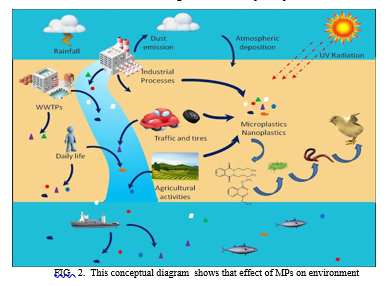
IV. EFFECT ON MICROPLASTICS ON MARINE
As microplastics are also found in very high amount from the marine base . Due to their small size the particles are eaten by the marine base animal and this are very harmful for their life . Because of this the toxic effects including reducing food intake , delaying growth, causing oxidative damage and abnormal behaviour. Previous studies shows that the impact of microplastic have been compared into marine mammals such as fish , marine plants, sponges, coral reefs, molluscs . Many reaches shows that 12.7 million plastic found and this is increasing day by day . It can have negative effects on aquatic marine either reactive oxygen and gene expression. To determine who many percent did microplastic particles are there in ocean base for that the water sample of tropical eastern Pacific had taken and the report shows that 100 percent microparticles are there in ocean base . Furthermore, different species approx 240 Marine organisms had tested and all organisms had intake microparticles. Microplastics particles ranging from 150 – 500 are most noticeable particles . The most increasing microparticles in the recent years a lot due to COVID 19 pandemic the worldwide production and disposal of face masks as well as other plastics laboratory and medical materials have increased very much . It is reported that 90 million plastic mask made every month and due to COVID 19 it’s increased very much . And this creates a challenge for the marine animals .
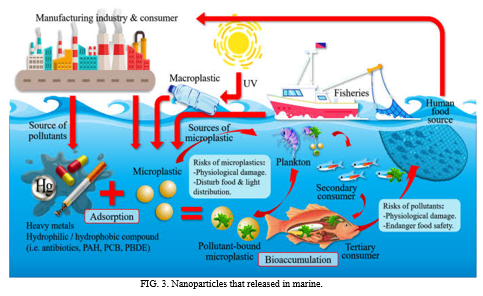
V. EFFECT OF MICROPLASTICS ON HUMAN HEALTH
As this Microplastics have hazardous effect on environment and marine as same as this effect also human health. Human may experience stress, oxidative, neurotoxicity, cytotoxicity and immune system disruption. The toxic effects on humans are still unknown. Because of microplastic particles this problem becomes chronic disease. Many more diseases such as diabetes, cancer, heart disease, Geno toxicity , cardiovascular and autoimmune disease. Microplastics enter the human body through consuming food, drinking water and breath air which is contaminated with microplastics . Moreover, this MP particles making their way through the intestine and being mix with the bloodstream. A study estimated that an adult consume about 300-600 every day. After the research it shows that people consume micro and nanoplastics approximately 5 to 6 grams every week. Microplastics are found in human blood, lungs and faeces. One study shows that faeces are more than about ten times in babies drinking from bottle than the adults.
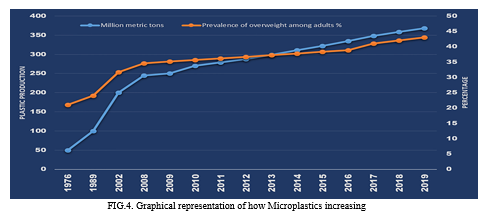
As all plastics were thought of as inert material serval research have described health risks from subjection to microplastic in human. Microplastics are very bad for the aquatic animal but the fish are the main factor has many humans consuming fish and the small fishes eaten by big fishes. The microplastic particles which can causes suffocation, starvation and drowning. Some of the chronic disease are serious damage on the gills, increase egg production in female fish, oxidative damage,. DNA damage, dysbiosis, mortality, slow down swimming.
VI. EFFECT ON MICROPLASTICS ON FRESHWATER
After releasing from the environment plastic may be transmit to wetlands, lakes and rivers. Human population density are higher the water bodies which are near are polluted with plastic pollution. As per the the lake Erie has a greater number of nearby cities with population exceeding 100,000 in its immediate watershed than any other lakes. By taking some sample water of lake Ontario . Scientists found an average of 760 microparticles found in freshwater. There are three potential ways of microplastic entering in freshwater. Microplastics enter through wastewater treatment, agricultural runoff from land treated with sludge and overflow of sewage water because of rainfall , solid waste, processing and collection.
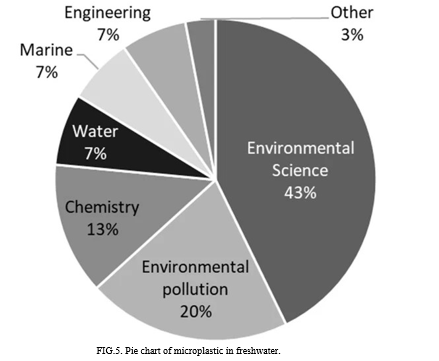
VII. REDUCING OF MICROPLASTICS IN DAILY LIFE
A. Buy Organic Clothes
Synthetic clothes such as polyester is a most contributor of microplastic. As all the types of clothes contains more or less microplastic. Cotton tend to stay longer than those clothes.
B. Use Public Transportation
Car tries are major source of microplastic . In cities that have heavy traffic this leads to a occurrence known as city dust. By using the public transportation rather than a personal car, this help to limit the overall amount of tire erosion and plastic pollution.
C. Buy Plastic Free Cosmetics
Cosmetics often include plastic components. Lotions and skin creams include microplastic particles. Most of these products containing small plastic particles and all these products are very hard to recycle. There are a lot of brands competing win over sustainability minded consumers that have phased out plastic components and have invested in alternative types of packaging.
D. Changing of Doing Laundry
Polyester t-shirt or yoga Pants contains microplastics . Clothing made from plastic is one of the biggest sources of microplastic pollution. A single load of laundry can release more than 1 million of microplastic fibres . This reduces by installing a filter in washing machine that catches microplastic. Or by lower settings is that the clothes aren’t thrown around with as much force which is what causes fibres to separate and pull away.
E. Don’t Microwave Food in Plastic Containers
A study of 2019 found that plastic which enter our body the half of plastic also enter through this plastic containers. The BPA and phthalates added to plastics in food items easily when the food heated. To wash plastic containers in the dishwasher too, as the heated water degrades the plastic.
F. Limited of Seafood Consumption
Microplastics have been found in 386 aquatic species, among them half of which are used commercially . The microplastic and nanoplastics which are even smaller can move from the stomach of fish into their muscle tissue. This is what humans eats. Moving towards vegan diet also fell on greenhouse gas . And is considered the one of the most environmentally beneficial life . So by avoiding to consuming fish also keeps plastic out of the ocean and benefits for human health.
G. Regularly of Dust and Vacuum
Alongside eating and drinking microplastic also enter through air into our body. These small particles of microplastic are mix up in the dust under beds, in corners, in tiny space inside the showpiece, curtains, moving in the air. By doing regular dusting and vacuuming can keep these microplastic from collecting and becoming inhaled by household members. Instead of using other vacuum use HEPA filter to clean so all the particles trapped inside the it rather than moving in the air.
VIII. INNOVATIVE METHOD OF DETECTION OF MICROPLASTICS
Study shows that particles that could be occupy across membrane in the human health. They filtered the blood to collect small particles of plastic between 700 nanometer and 500,000 nanometer. For avoiding this the researchers has used glass fiber filter to avoid this situations.
The scientists looked for the five common plastics:
- Polypropylene, this commonly used for the packaging and textile.
- Polyethylene terephthalate, commonly used in purpose of textiles and food and drink containers.
- Polyethylene, this most commonly used the plastic, used making plastics bag and many other items also.
- Polymerized styrene, this use in light weighing packages.
Poly(methyl methylacetate) this is used for treatment of disease and other medical purpose.
IX. ADVANTAGES OF MICROPLASTICS
It has low production as per the cost.
It can be used in any shape , size and texture.
It has light weight.
It is poor conductor of electricity.
It is poor conductor of heat.
It is also used for construction purpose also.
As this are some advantages of plastic but still the causes of plastic or its disadvantage are many more harmful and hazardous. The plastic is breaking down into very tiny particles and is known as micro Oxidative damage and cell death
After many studies have shown various polystyrene nanoplastics particles can cause oxidative stress or damage and cell death. It shows that Cationic polystyrene nanoparticles can cause reactive oxygen species (ROS) production and endoplasmic reticulum. Moreover, the toxic effects damage liver, ileum , intestine, testes, lungs, heart , spleen , kidneys . This known after testing on mouse . But it also have some of the effects like altered lipid metabolism was notice in the offspring of the mice due to microplastic and nanoplastics particles.
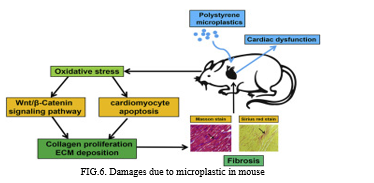
X. FUTURE SCOPE
- Are the microplastic able to assemble in the human body?
- What proportion of microplastic particles display do Microplastics comprises?
- Do the large size of plastic damages a lot or same?
- Does the surface charge of microplastic affect are hazardous and does this differ with the time in atmosphere?
- Does spreading or annulment occur?
- Does subcellular location or translocation occur.
XI. ACKNOWLEDGEMENT
We would like to thank our guide Shivrajsinh Rayjada who gave us this opportunity to make this research paper. He helps a lot throughout the paper. And we also like to thank to our parents who supports us.
Conclusion
While , microplastic and nanoplastics are widely spread in marine, environment, human health, fresh water and almost around us . This became a source of study . It’s damages , stress and it’s harmful particles. The size of microplastic is less than five millimetres in length. And due it’s small size it enters the human body through various types. With the help of technology the microplastic particles can be sampled and divide into different characteristics. To reduce microplastic pollution should do recycling of the plastic and if is possible to use very little amount of plastic. Because it is threat for not only human body but also for environment and marine mammals . The intake of microplastic into human blood their fate and still controversial and not much well known .
References
[1] https://www.frontiersin.org/files/Articles/724989/fendo-12-724989-HTML/image_m/fendo-12-724989-g001.jpg [2] https://ahmedabadmirror.com/scientists-find-microplastics-in-human-blood-for-first-time/81826105.html [3] https://www.medicalnewstoday.com/articles/could-microplastics-in-human-blood-pose-a-health-risk [4] https://www.sciencedirect.com/science/article/pii/S0025326X11003055 [5] https://www.google.com/url?q=https://www.mdpi.com/2073-4441/14/11/1737&usg=AOvVaw1C1fY_YnTXg_7hrjDQKQ [6] -rhttps://www.google.com/url?q=https://dfzljdn9uc3pi.cloudfront.net/2022/13503/1/fig-2-full.png&usg=AOvVaw3pH2460KPokH-Ec75Nqt_e [7] https://journals.plos.org/plosone/article?id=10.1371/journal.pone.0280594 [8] https://www.google.com/imgres?imgurl=https%3A%2F%2Fwww.researchgate.net%2Fpublication%2F338554921%2Ffigure%2Ffig3%2FAS%3A846879420076035%401578923196253%2FPathways-of-distribution-of-microplastic-into-the-environment.jpg&tbnid=Hbn89VKAucwLAM&vet=1&imgrefurl=https%3A%2F%2Fwww.researchgate.net%2Ffigure%2FPathways-of-distribution-of-microplastic-into-the-environment_fig3_338554921&docid=ZJeTIif04ZIw0M&w=850&h=699&itg=1&hl=en-GB&source=sh%2Fx%2Fim [9] https://images.app.goo.gl/wdUBFx4zEHXABnDPA
Copyright
Copyright © 2023 Hetu Vadhadiya , Henshi Kacha , Shivrajsinh Rayjada . This is an open access article distributed under the Creative Commons Attribution License, which permits unrestricted use, distribution, and reproduction in any medium, provided the original work is properly cited.

Download Paper
Paper Id : IJRASET50120
Publish Date : 2023-04-05
ISSN : 2321-9653
Publisher Name : IJRASET
DOI Link : Click Here
 Submit Paper Online
Submit Paper Online

